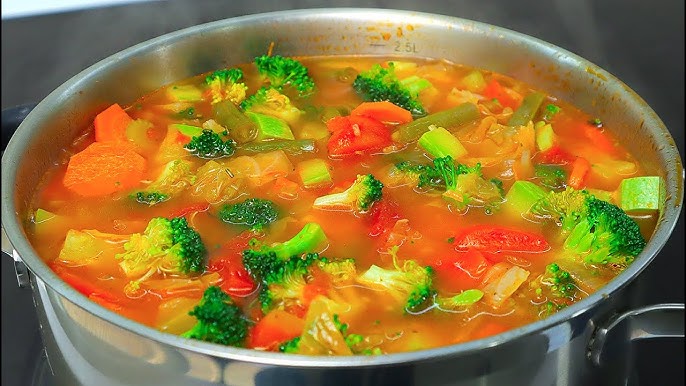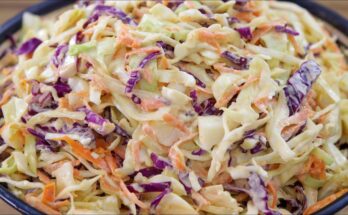Weight Loss Cabbage Soup Recipe: Trying to shed some pounds without starving yourself? You’re in for a treat—literally. The weight loss cabbage soup isn’t just another trendy diet fad. It’s a hearty, flavorful, and incredibly effective way to fuel your body while torching calories.
This soup is a favorite among those looking to drop a few pounds quickly, and today, we’re going to break down how to make it step-by-step, what makes it so effective, and how you can store it for later.
Let’s dive into the bowl!
Introduction to Weight Loss Cabbage Soup
Why Cabbage Soup is a Popular Weight Loss Meal
Cabbage soup has been around for decades, gaining fame as a “miracle soup” in various weight-loss circles. But what makes it so popular? The answer lies in its simplicity and power. It’s made primarily with vegetables—especially cabbage—so it’s naturally low in calories yet high in volume. That means you can eat generous portions without overloading on calories. It also fills you up fast thanks to its high fiber content, which keeps hunger at bay longer.
Another reason it’s popular is the speed of results. While it’s not meant to be a long-term diet, many people see a noticeable drop in weight within just 7 days. That quick success can be incredibly motivating if you’re jumpstarting a health journey or prepping for a big event.
And let’s not forget—it’s cheap! You don’t need fancy ingredients. Just basic, fresh vegetables, herbs, and spices. Whether you’re a kitchen pro or a complete beginner, this soup is virtually fail-proof.
The Science Behind the Cabbage Soup Diet
The cabbage soup diet revolves around the principle of calorie deficit—burning more calories than you consume. Cabbage, being extremely low in calories and high in water and fiber, becomes the perfect base for a “negative-calorie” meal.
It doesn’t mean the soup burns fat directly, but it supports your body in doing so by offering minimal calories while requiring energy to digest. Think of it as food that works hard for you. Additionally, cabbage is packed with antioxidants and vitamins like C and K, which boost your immune system during this diet phase.
Now, combine it with other low-calorie vegetables and metabolism-boosting spices like black pepper, garlic, and chili flakes, and you’ve got yourself a powerful detox soup. It cleanses, nourishes, and energizes all in one go.
Health Benefits of Cabbage Soup
Nutritional Value of Cabbage
Cabbage might not look like a superhero on your plate, but nutritionally, it’s a powerhouse. One cup of chopped cabbage has only about 22 calories, yet it delivers a solid dose of:
- Vitamin C (over 50% of your daily requirement)
- Vitamin K
- Folate
- Manganese
- Fiber
It’s also rich in antioxidants, which combat inflammation and help your body fend off chronic diseases. If you’re looking for food that nourishes without fattening, cabbage is your new best friend.
Low-Calorie, High-Fiber Advantages
Here’s the deal: high-fiber foods like cabbage not only fill you up—they keep you full longer. That means less snacking, less overeating, and a more satisfied belly.
In a weight loss plan, fiber plays a critical role. It slows down digestion, stabilizes blood sugar levels, and improves gut health. Meanwhile, the soup itself is broth-based, meaning it has high water content. This makes it hydrating and volume-rich, offering fullness without the fat.
Eating cabbage soup as a meal replacement can create a healthy calorie deficit without making you feel deprived. And let’s be honest—when you’re not constantly hungry, staying on track becomes a whole lot easier.
Detoxification and Digestive Benefits
One of the often-overlooked advantages of cabbage soup is its natural detoxifying properties. Cabbage contains compounds like glucosinolates and sulfur, which support liver function—the body’s main detox organ.
During a cabbage soup cleanse, you’re eliminating processed foods and replacing them with whole, plant-based ingredients. That’s a win for your digestive system. The soup acts as a gentle cleanser, promoting regular bowel movements and flushing out toxins.
Plus, the warm broth soothes the digestive tract and reduces bloating. If you’ve been feeling sluggish or puffy, a few days on this soup might be just what your body needs to reset.
Ingredients You’ll Need
Fresh Vegetables to Use
Let’s start with the stars of the show. The key vegetables in cabbage soup include:
- Green cabbage (shredded or chopped)
- Onions (yellow or white, sliced thin)
- Carrots (diced or julienned)
- Celery stalks (chopped)
- Bell peppers (green or red for sweetness)
- Tomatoes (diced or canned with juice)
- Garlic cloves (minced)
These veggies not only bring flavor and texture but also a wide array of vitamins, minerals, and antioxidants. They’re low in calories, high in nutrients, and make the soup colorful and tasty.
Spices and Seasonings That Boost Metabolism
Now let’s crank up the flavor. These seasonings do more than just enhance taste—they can help fire up your metabolism too:
- Black pepper – aids digestion and absorption
- Cayenne pepper or chili flakes – increases thermogenesis
- Turmeric – anti-inflammatory and detoxifying
- Cumin – supports digestion and metabolism
- Ginger – soothes the stomach and boosts fat burn
- Salt (moderate) – for taste
Herbs like parsley, basil, or thyme can be added for aroma and freshness. Don’t underestimate the power of a few spices to turn a bland bowl into something crave-worthy.
Optional Add-ins for Extra Flavor
Want to customize your soup a bit? Here are some optional ingredients that won’t ruin your weight loss goals:
- Low-sodium vegetable broth instead of water for richer taste
- Mushrooms for umami depth
- Green beans or zucchini for variety
- A splash of lemon juice for brightness
- A dash of apple cider vinegar for a metabolism kick
These additions give you flexibility while still keeping the meal healthy and effective for fat loss.
Step-by-Step Guide to Making Weight Loss Cabbage Soup
Step 1: Gather and Prepare Ingredients
Before you even fire up the stove, prep is key. Wash and chop all your vegetables. Shred your cabbage, dice your tomatoes, and slice your carrots and celery thinly so they cook evenly.
Pro tip: Use a big pot—like, really big. This recipe makes multiple servings and you’ll want leftovers. Don’t skimp on quality, either. Fresh vegetables make a difference in flavor and nutrition.
Once everything’s prepped, place it all within reach. Cooking is way more fun when you’re not scrambling to find the garlic mid-sauté.
Step 2: Sautéing for Flavor
This step is often skipped—but trust me, it makes a huge difference. Start by heating a tablespoon of olive oil (or use a splash of vegetable broth if you’re going oil-free) in your large pot over medium heat. Add the chopped onions and garlic first. Let them sauté for about 5 minutes until they become translucent and aromatic. This base layer infuses the entire soup with rich flavor, something you definitely don’t want to miss.
Next, toss in the carrots, celery, and bell peppers. Sauté these for another 5–7 minutes. This helps release their natural sugars and gives them a slightly caramelized taste. If you want your soup to be seriously flavorful without added calories, this step is non-negotiable.
Once everything is slightly softened, sprinkle in your chosen spices—black pepper, chili flakes, turmeric, and a pinch of salt. Stir everything well so the spices coat the veggies. Your kitchen should smell absolutely heavenly by now.
Step 3: Simmer to Perfection
After sautéing, it’s time to bring the soup together. Add your chopped cabbage and tomatoes (including their juices if canned). Pour in enough water or low-sodium vegetable broth to fully cover the veggies—about 6 to 8 cups should do the trick.
Crank up the heat and bring it all to a boil. Once boiling, reduce the heat to low, cover with a lid, and let it simmer. This is where the magic happens. Simmer for 30 to 45 minutes, or until all the vegetables are tender and the flavors have melded together.
Don’t forget to taste and adjust the seasonings. Need more heat? Add extra chili flakes. Want it brighter? A squeeze of lemon goes a long way. The longer it simmers, the deeper the flavor, so feel free to let it sit on low for an hour if you have the time.
By the end, you’ll have a rich, flavorful soup that’s light, hearty, and perfect for weight loss. Eat a bowl whenever hunger strikes—you can feel full without the guilt.
How to Store and Reheat Cabbage Soup
Storing in the Refrigerator or Freezer
One of the best things about cabbage soup? It stores like a dream. After the soup cools, transfer it into airtight containers. In the refrigerator, it stays fresh for up to 5 days. Just make sure it’s completely cooled before sealing to avoid condensation, which can water down the soup.
Want to make a big batch and freeze for future meals? No problem. Portion the soup into freezer-safe containers or bags, label them with the date, and freeze for up to 2–3 months. When you need a quick, healthy meal, just thaw and heat. You’ll thank yourself later.
Tip: Freeze individual servings for portion control and easy grab-and-go lunches.
Best Practices for Reheating
Reheating cabbage soup is simple but important if you want to maintain its texture and flavor. For best results:
- Stovetop method: Pour your desired portion into a small pot and reheat over medium heat, stirring occasionally until hot.
- Microwave method: Place the soup in a microwave-safe bowl, cover loosely, and heat in 1-minute intervals, stirring in between.
Avoid overcooking the soup when reheating, especially if it’s already soft. You want to preserve some of that veggie bite. A dash of fresh herbs or a squeeze of lemon before serving can refresh the flavor after reheating.
Tips for Maximizing Weight Loss with Cabbage Soup
Use it as Part of a Balanced Diet
Cabbage soup alone won’t magically melt away pounds if the rest of your meals are packed with junk. The key is to incorporate it into a smart eating strategy. Use the soup as a meal replacement once or twice a day, preferably for lunch and dinner. This keeps your calorie intake low while still providing essential nutrients.
For breakfast, go with something light but protein-rich like Greek yogurt, eggs, or a smoothie with added protein powder. The point is to create a sustainable calorie deficit without starving yourself or lacking nutrition.
Avoid pairing cabbage soup with refined carbs or high-fat foods. Skip the bread, cheese, and processed snacks. Think lean, clean, and green. If you stick to the basics, the weight will start to come off—sometimes faster than expected.
Stay Hydrated and Avoid Processed Foods
You might not realize it, but hydration plays a massive role in your weight loss journey. Drinking plenty of water while doing a cabbage soup diet helps flush out toxins, keeps your metabolism humming, and reduces bloating.
Aim for at least 8 glasses of water daily. You can also sip on herbal teas or infused water with lemon, cucumber, or mint. These not only hydrate but also help curb cravings.
Also, eliminate processed foods as much as possible during your cabbage soup phase. These contain hidden sugars, unhealthy fats, and sodium that can counteract your progress. Stick to whole foods—fruits, vegetables, lean meats, and whole grains when you’re not eating the soup.
Incorporate Light Exercise
While the cabbage soup is doing its job inside, adding a bit of physical activity can accelerate your results. We’re not talking hardcore gym sessions here. Even brisk walking, light yoga, or home workouts can increase calorie burn and tone your body.
Try to get at least 30 minutes of movement a day. Even better—do it after meals to help digestion and burn off some of those calories right away.
Cabbage soup gives you energy without the crash. Use that extra energy to move your body, and you’ll feel the difference—both mentally and physically.
Possible Side Effects and How to Handle Them
Managing Hunger and Low Energy
Let’s be honest—eating cabbage soup all day can get boring. And yes, you might feel a bit low on energy during the first couple of days, especially if you’re used to a higher-calorie diet. That’s totally normal and temporary.
To manage hunger, keep raw veggies like cucumbers or carrots handy for snacking. You can also add a small serving of lean protein like chicken or tofu to your soup to keep you fuller longer without ruining the calorie count.
If you’re feeling drained, a spoon of natural peanut butter or a small banana can give you a quick energy boost. Just don’t go overboard. The idea is to stay within your daily calorie target while still feeling nourished.
Dealing with Digestive Changes
Because cabbage soup is high in fiber, your digestive system might go into overdrive—at least at first. You might experience some gas or bloating in the beginning, especially if you’re not used to eating this many veggies.
Don’t worry—it usually settles down after a couple of days as your body adjusts. Drinking water, walking after meals, and sipping on herbal teas like peppermint or ginger can help soothe your gut.
If the soup makes you feel too bloated, try reducing the portion size or cooking the vegetables longer to make them easier to digest.
How Long Should You Follow the Cabbage Soup Diet?
Recommended Duration
The cabbage soup diet isn’t meant to be followed long-term. Most people do it for 7 days, which is typically enough to see noticeable weight loss—anywhere from 5 to 10 pounds, depending on your body and metabolism.
You can repeat the diet every couple of months if you need another jumpstart, but always give your body a break in between. Use the time between cycles to eat balanced, nutrient-rich meals that support your new lower weight.
This approach helps you maintain the weight loss without feeling like you’re always dieting. Think of it as a tool in your wellness toolkit—not a lifestyle.
When to Stop or Modify the Diet
If you start to feel too fatigued, dizzy, or unwell while on the soup diet, it’s okay to stop. Your health always comes first. Some people choose to modify the diet by including a small serving of lean protein or healthy fat each day to prevent those symptoms.
Listen to your body. The soup is a great helper, but it’s not magic. Combine it with smart choices and you’ll see better, longer-lasting results.
FAQs about Weight Loss Cabbage Soup Recipe
1. Can I eat cabbage soup every day?
Yes, but it’s best to eat it for a few days at a time as part of a short-term diet plan. Long-term use can be restrictive and may not provide all the nutrients your body needs.
2. Can I add meat to my cabbage soup?
Absolutely. Adding lean chicken or turkey can make the soup more filling and help maintain muscle mass while losing fat.
3. Is the cabbage soup diet safe?
For short-term use (like 7 days), it’s generally safe for most people. However, it’s always a good idea to check with a healthcare provider, especially if you have health conditions.
4. Will I gain the weight back after the cabbage soup diet?
If you return to unhealthy eating habits, yes. The key is to use the diet as a reset and continue eating clean afterward to maintain your progress.
5. Can I freeze cabbage soup?
Yes! It freezes well for up to 2–3 months. Store it in airtight containers or freezer bags for best results.
Conclusion
The weight loss cabbage soup recipe is more than just a quick fix—it’s a flavorful, nourishing way to reset your diet and shed a few pounds fast. Whether you’re prepping for an event, kickstarting a health goal, or simply want to feel lighter and more energized, this soup delivers.
Made with simple ingredients, loaded with fiber, and easy to customize, it’s a go-to option for many looking for sustainable weight loss. Follow the step-by-step guide, store it properly, and incorporate it into a healthy lifestyle for best results.
Remember, it’s not about perfection. It’s about progress—one delicious bowl at a time.



